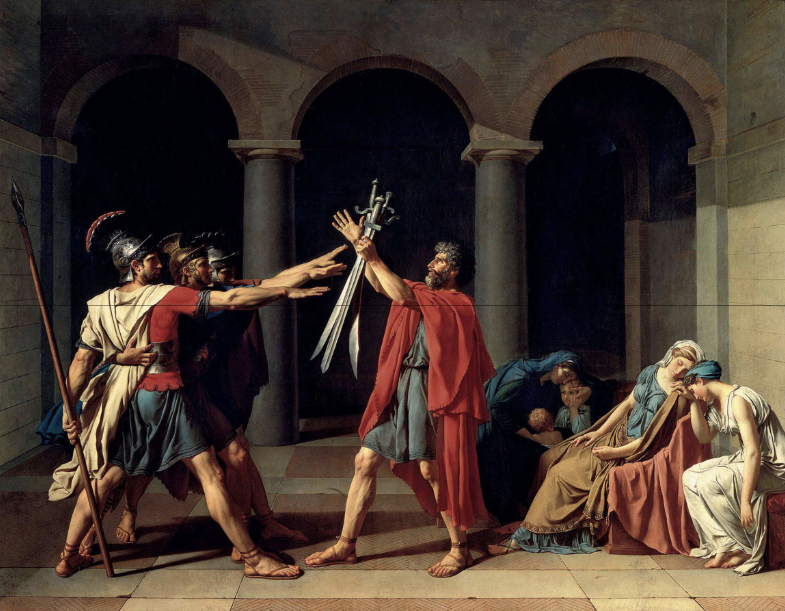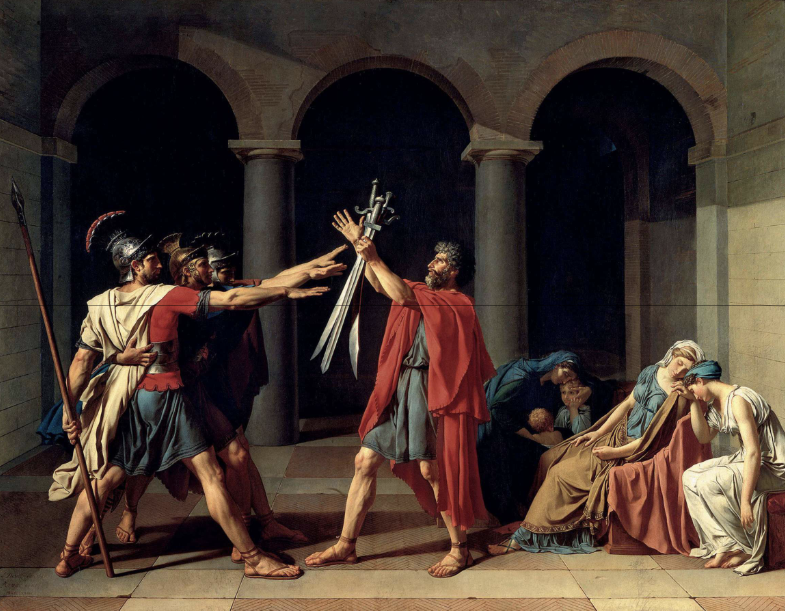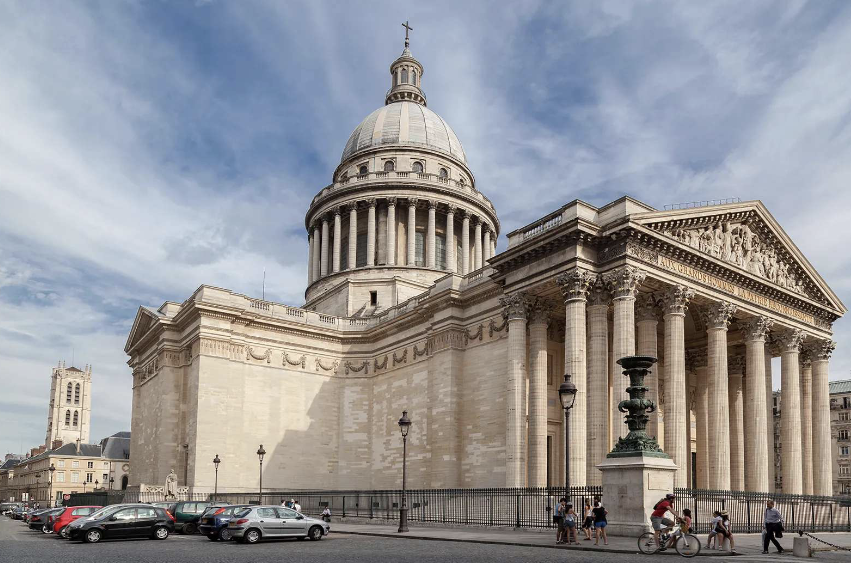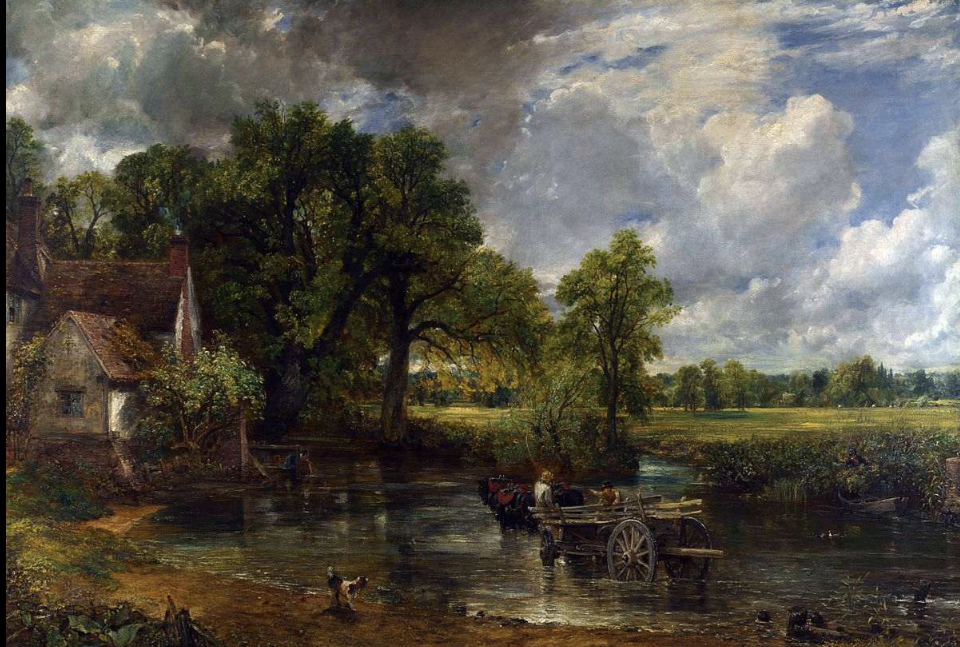Neoclassicism and Romanticism
1/27
There's no tags or description
Looks like no tags are added yet.
Name | Mastery | Learn | Test | Matching | Spaced |
|---|
No study sessions yet.
28 Terms
What was Rococo art for? What were some of its characteristics?
Rococo was an unserious rebellion against the Baroque
hold of absolutist monarchy relaxes and the elites indulge themselves
art for private salons of the elites
more playful, deliberately detached from politics
for pleasure
When does neoclassicism emerge?
second half of 18th century
What was the start of neoclassicism like?
outside the walls of private salons
economic growth
authority of church and monarchy is waning and being challenged
literacy spreading
printing presses
public wants to think, debate and understand the world themselves
reason, rationality
not through divine revelation or religious texts
When and what was the enlightenment?
18th century across Europe
emphasized reason, science, technology, inquiry, empirical observation
collecting data
empirical observation > inherited traditions
How did Isaac Newton contribute to the Enlightenment?
he practiced observation and experimentation
mathematical proofs
model for enlightenment thinking
applying these formulas and models to society and politics
Who was John Locke? What were his ideas?
philosopher
ideas that deeply influenced politics
natural rights (life, liberty, property)
proposed that governments exist to protect these right and not to accumulate wealth
if governments don’t follow this, citizens have the right to revoke and rebel against
his ideas inspired different revolutions
Who were some of the french enlightenment thinkers?
Les Philosophes
e.g. Voltaire, Diderot, Montesquieu, etc.
What did Diderot write and what was its purpose?
Encyclopédie
he gathered all human knowledge from different disciplines (science, technology, art)
goal was not to inform but to empower the public to make knowledge accessible beyond elite circles
promoted reason as a tool for social progress
Popularize concepts, disciplines, areas of knowledge and make them readily available to the general public
What were the core values of the enlightenment?
education, empirical evidence, rational thought, critical inquiry, secular over religious thinking, belief in progress
What was the renewed interest in classical antiquity? How was it different from the revival in the Renaissance?
looked back to ancient Greece and Rome not just to admire beautiful work but to engage with political and ethical ideas
looked to Plato, Aristotle, Seneca, Cicero
the art of governance
civic virtue, justice, citizenship
enlightenment thinkers looked at classical texts that discussed politics, civic virtue, government, etc.
resonated with Locke’s ideas of democracy, good government, etc.
What did artists and people believe in terms of the role of art during this time of enlightenment? Why was Rococo rejected?
art should do more than just entertain and it should reflect reason, justice, laws, etc.
Diderot in particular turned against Rococo
it is immoral because it only focused on pleasure and entertainment
wanted art to be serious and morally instructive
something with weight

Name and iconographic analysis
Jacques-Louis David, Oath of the Horatii, 1784. Oil on canvas.
represents an enlightenment turn
stand with arms outstretched
brothers swearing an oath to their father
to defend Rome from an enemy state
at the cost of their lives
serious, grave moment
women sit in sorrow
they know that their family will be torn apart due to this conflict
some of them are related to the enemy (Alalonga)
exercise of civic duty/heroic act
clear instructive political message
how we the citizens ought to behave
even in emotionally difficult situations
collective duty above private interests
reason over emotion
didactic

More on formal analysis
men are geometric and form sharp diagonals
increased strength, rationality, rigidity
women are curved and postures are soft
overcome by grief
reflected the gender norms of the time
draws on classical antiquity though story from ancient Rome
roman legend about civic virtue and public sacrifice
figures are pushed to forefront since David was inspired by friezes
background is neutral and features arches for mapping humans like a grid
light is even
composition reflects the values of the enlightenment
rationality, clarity, legible structure
no more asymmetry
balanced
clear narrative
no ambiguity
What was David attempting to do through this work?
attempting to educate through art
artists now have a mission to educate the public
he was inspired by Greek and Roman styles
How was Neoclassicism different from Renaissance?
Renaissance was about new and innovation
Now we were copying the Greeks and Romans and imitating
since they all worked on perfecting a singular thing
What was the French Revolution and David’s role?
began in 1789, ended in late 1790s
due to widespread anger over economic inequality, heavy taxes and absolute monarchy
enlightenment influence
ended absolutist monarchy
Jacobins organized people but they were very radical
as a result France became a republic government
David sided with the Jacobins and accepted the role of art propaganda
believed that art could educate the public
post-revolution he displayed events from revolution
e.g. Death of Marat
When did Napoleon come to power?
comes to power in 1799 and crowned emperor in 1804

Jaques-Germain Soufflot, Pantheon (Sainte-Geneviève; interior), Paris, France, 1755-1792.
corinthian columns
friezes
some with latin scripture
stylobate
symmetrical composition
dome
central plan
walls are austere and simple
shows purity and restraint
architecture tells you about the values and core principles of the enlightenment
facade feature a portico with Corinthian columns
come from existing Roman columns in Lebanon
not inspired or spolia but instead exact minute reproductions of existing columns
this is the spirit of the enlightenment
exact, scientific precision
dedicated to people that had civic virtue during the revolution
Recap: How does neoclassicism emerge?
emerges out of empiricism and inspiration of classical antiquity and they come together
Timeline of revolution, neoclassicism and romanticism
neoclassicism emerges just before revolution
radicalized and consolidated during revolution
more didactic after revolution
promoted by French Academy
moving into 19th century, neoclassicism is most supported
1870 → Romanticism had captured artists and the public
Romanticism time period
1800-1840
doesn’t necessarily dethrone neoclassicism
What was Romanticism triggered by? What was the overall style?
triggered by Napoleon’s series of defeats
France had a bitter feeling of lost and defeat
mood in France was similar to that of Hellenistic period in Greece
darker mysterious, morbid
dynamic, moody, romanticism

Jean Louis Théodore Géricault, The Raft of the Medusa, 1818-1819
immense canvas
figures are larger than life
depicts a real story of a shipwreck where ship Medusa crashed due to incompetence of captain (political appointee)
built a make-shift raft and survived for 13 days
via cannibalism
dark scene
multi-figure composition
dynamism
hodge-podge of swirling bodies, overlapping
no clear central axis, unstable composition
illusion to triangular composition with mass and ropes and human figures emerging
emotion over reason
no civic virtue
embracing weakness of men

Compare and contrast in terms of message, emotional tone, composition/form, use of light and colour
Message
Moral clarity vs. social injustice/government failure
Emotional tone
Stoic/rational scene (emotions are present but restrained), cerebral, not meant to stir any significant emotions vs. raw, dramatic, filled with horror and desperation, slight hope, appeals to viewers emotions and empathy
Composition and form
Balanced, symmetrical, clear geometry, vertical and horizontal lines vs. chaotic, diagonals that pull the viewers eyes, figures are twisting and struggling, pile of bodies all suffering
Use of light and colour
Colour palette is clean, even lighting, harmonious, contrasting colours (blue and red), neutral background and pops of colours in foreground to walk us through narrative vs. earthy, stormy tones that reflect reality, natural setting
What was the Romantic interest in the sublime?
feeling of awe mixed with terror
not gory or morbid
thrilling and grand
terrifying and awe-inspiring
recognition of our smallness in the face of nature’s power
human figures placed in untamed nature landscapes

Caspar David Friedrich, Wanderer above a Sea of Mist, 1817-1818. Oil on canvas.
stands stably on cliff
centrally positioned add to stability of posture
triangular symmetrical cliff support
he is safe and yet in front of him flows a sea of mist and rock outcrops
viewer is positioned at the level of the man’s head and we feel as though we are sharing this view
deeper sense of empathy
in particular for male salon viewers

John Constable, The Hay Wain, 1821. Oil on canvas.
British painters weren’t focused on stormy seas of mountaintops
for them the threatening force was the industrial revolution for the countryside
human power and development
factories, railways, mass production that were taking over traditional lifestyles
overall serene and pastoral scene
calm, familiar
gentle irregularity
soft lines
delicate brush work
figures are at ease and living
harmony between nature and humans
Doesn't show the economic collapse instead it offers a nostalgic image of a harmonious countryside (a fantasy and a longing)
hint of unease in dark cloud
this calm is fragile and change is coming
melancholy
What were the three moods of the Romantic period?
Human Struggle and Social Injustice
sublime (terror mixed with awe)
melancholy and sentimentality